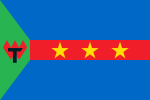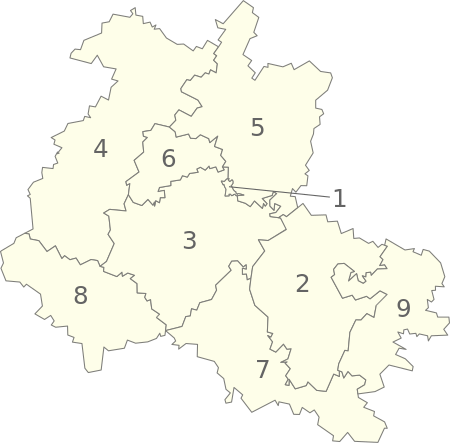Federal Republic of Baijania
Federal Republic of Baijania | |
|---|---|
| Motto: 民主-聯邦-自由 (Chinese) "Democracy-Federation-Liberty" | |
| Anthem: 我的共和國 (Chinese) "Our Republic" | |
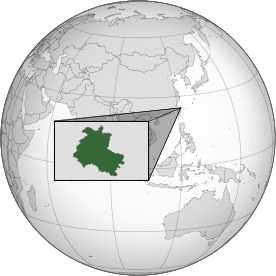 | |
| Capital | Jijinhui City |
| Largest city | Republic of Zuán-an |
| Other languages | Chinese |
| Demonym(s) | Baijanian |
| Government | Federal state presidential republic |
• President | Ting-wei Bai |
| Establishment | |
• first foundation regime | May 23, 2015 |
• federal government established | June 23, 2018 |
• 2019 Constitution passed | Jenuary 19, 2019 |
• 2021 Constitution passed | August 13, 2021 |
• Suspended | September 28, 2021 |
• reopening of the government | June 23, 2022 |
| Population | |
• 2019 census | 59 |
| Currency | New Taiwan dollar (NT$) |
| Time zone | UTC+8 (National Standard Time) |
the Federal Republic of Baijania (Chinese: 拜然聯邦共和國, Bàirán liánbāng gònghéguó), simply known as Baijania (Chinese: 拜然尼亞, Bàiránníyǎ、拜然, Bàirán) or FRB (Chinese: 拜聯, Bàilián)[1], is a micronation located on the island of Taiwan in eastern Asia. Baijania is a federal presidential republic.
The country is borders the Nuannuan District of Keelung City in Taiwan. The claimed territory of Baijania is 0.44 square kilometers. The Federal Republic of Baijania was established on June 23, 2018 as the successor of the Federal Republic of Tinweiland and the Old Baijanian Federation.
Etymology
According to legend, the name of Baijania was derived from the Slavic "torch (Russian:факел) " with many accents; or it was named after the surname of "Bai (白)" by the residents of the nearby area; this term has been frequently used since 2018 .
The old name "Great Tinweiland (Chinese: 大庭瑋蘭, Dà Tíngwěilán)" by Baijania was abandoned due to political factors and the prohibition of cult of personality.
History
Early days
On May 23, 2015, a number of "foundations (Chinese: 基金會政權)" were established in the Keelung Nuannuan area in northern Taiwan, including the Bai's Foundation (Chinese: 白氏基金會), the predecessor of Baijania, which was co-founded by Tingwei Bai (Chinese: 白庭瑋) and Yujie Zheng (Chinese: 鄭宇傑); On June 23, the foundation was formally established as a nation, but it was renamed United Zheng's Foundation (Chinese: 鄭聯會) a day later. This period is called the "First Republic (Chinese:第一共和國)". Tingwei Bai left United Zheng's Foundation.
On September 20, 2016, Bai Tingwei established the New Bai's Foundation (Chinese: 新白氏基金會) and replaced the United Zheng's Foundation. The former Zheng's government moved to the Zhengdao region and reorganized into the State of Zheng (Chinese: 鄭聯國). The Great Keelung Foundation (Chinese: 海峽兩岸大基會) on the northern border was merged into the New Bai's Foundation and restructured into the Hostown Autonomous Region (now Dongshixi Region). On November 20, 2016, the New Bai’s Foundation changed its name to Republic of Tinwei and continued the title of "First Republic".
During this period of time, the territory of the First Republic continued to expand, but only claimed territory. Tinwei Bai also tried to form a party for the National Republican Party of Tinwei (Chinese: 國家共和黨).
Try to Establish a State Union
In March 2017, the Zhengdao region conducted international exchanges with the First Republic of Tingwei for the first time and contributed to the establishment of a State Union (Chinese: 國家聯盟). Although it is called the "Union", this period is called the "Ting Zheng Confederate Period (Chinese: 庭鄭邦聯時期)". The two states actually operate independently, and the leadership is not clear about the power division of the union, so conflicts often occur.
Two months later, on May 18, the state union disintegrated, and part of the territory that originally belonged to the Republic of Tinwei was ceded to the more powerful State of Zheng. The leftists in the country also established the Socialist Republic until May 22, when the NRP negotiated with the Socialist Republic, and then was reorganized into the Independent Democratic State (Chinese: 庭瑋民主獨立國), also known as the "Second Republic (Chinese: 第二共和國)".
Regain Lost Ground
After the establishment of the Second Republic, the two sides had a tough attitude towards the State of Zheng. The two sides repeatedly broke out serious conflicts. However, the Second Republic relied on its geographical advantages and finally annexed the States of Zheng. This move became the last straw for the second disintegration of the Republic in the future.
On October 1, 2017, the southwestern region of the Republic held a referendum on independence to formally become the Kyzyl-Tuva Republic (Chinese: 克孜勒-土瓦共和國), with the consent of the central government, but the premise is that both parties must form a federal government. Although the rights and interests of the central government have been greatly damaged, This is also another attempt at federalism. On October 2, the Republic of Mongol Ulus (Chinese: 蒙古兀魯斯共和國) was established; on October 20, the Republic of Olab (Chinese: 奧拉伯共和國) was established; on the same day, the Second Republic was reorganized into the Federal Republic of Tinweiland (Chinese: 庭瑋聯邦共和國), which was the First Federation (Chinese: 第一聯邦).On October 21, the Republic of Olab was renamed the Republic of Igiput (Chinese: 伊吉浦特共和國).
During this time, the "Autonomous Republic (Chinese: 自治共和國)" emerged for the first time as an administrative region and federal sovereign entity.
The Second Crash and The Second Federation
In April 2018, unknown reasons caused the First Federation to expel the three republics from the autonomous republics, and the country fell apart again. On May 8, the Second Federation was established, known as the Old Baijanian Federation.
This is the first time in the history of the region that the leader is not used as the name of the country, and it is also the first time that the word "Baijania" has appeared.
On June 23, 2018, the Federal Republic of Baijania was established. There is nothing special about this day, and it is only a continuation of the Second Federation. But in the future, this day will be regarded as the most important day of the Federation or the Federal Republic.
Access to Outside Information
In early October 2018, the leaders of the Republic of Sinhankon (Chinese: 新韓康共和國) exchanged information with Tingwei Bai. This was the first contact with micronations outside the Baijania. On October 11, the Republic of Terwas (Chinese: 特維斯共和國) and the Federal Republic of Baijania established official diplomatic relations, making it the first country with diplomatic relations. On the same day, the federal government officially launched the "Government Rejuvenation Project (Chinese: 復興政府計畫、復興計畫)", with the establishment of external platforms, portal website, and democratization as its primary goals.
On October 12, the Republic of Chrisland (Chinese: 克里斯蘭共和國) - the best friend of Baijania in the future, established diplomatic relations with the federal government. On October 28, 2018, Federal President Tingwei Bai participated in the National Day of the Republic of ChungNing (Chinese: 中寧民國) and signed the "Treaty of Yat-sen (Chinese: 逸仙條約)" with the founding father of ChungNing, Prime Minister of Chrisland, and the President of the Republic of Stone (Chinese: 史東共和國). On the same day, the President declared the Federal Republic of Baijania as a neutral country.
At the end of 2018, Sinhankon created disputes and established a puppet state for no reason. The federal government and a number of friendly countries imposed sanctions on Sinhankon, and the Sinhankon government eventually fell. So December 31 is the "Anti-Puppet State Victory Day (Chinese: 反傀儡集團勝利紀念日)" of Baijania.
Continuous development in 2019
In January 2019, the national land was officially recognized as "Baijania" instead of the "Great Tinweiland".
In this year, Baijania continued to establish diplomatic relations with many micronations and participated in many intermicronational activities, and joined the Taiwanese Micronations Community at the end of July.
In January 2019, the first presidential and parliamentary (Chinese: 立法院) elections were held. Tingwei Bai was victorious and began his first term after the Federal Constitution.
The movement to regain lost land in Baijania is still going on until August 15 to unify the whole territory. This year, the Ministry of Media (Chinese: 傳播媒體部) of Baijania announced the ID card, establishing the census and nationality.
At the end of 2019, because most people need to take entrance examinations, Baijania was suspended until January 21, 2020.
Although the new coronavirus (COVID-19) began to spread throughout the world in January, Baijania held a new presidential and parliamentary election, and was elected by Chenghan Lin of the Radiant Fatherland Party. In February, Baijania joined the Union of Micronations. In response to the epidemic, Baijania established an epidemic information management office.
During Lin's presidency, the religion and gender equality of Baijania were significantly improved.
Since most of the population will go to university in June 2020, Baijania urgently implemented the government online and completed the plan on the eve of graduation.
2021: a year of drastic changes
In January 2021, the general election will be held again, which is also the first election in which all the citizens of Baijania have voted online. Tingwei Bai of the Radiant Fatherland Party won the election and took office on Kinmen Island on February 25. In the same month, due to the approval of the "Bobby Kingdom Trust Territory Case (Chinese: 波比王國託管案)" by the Taiwanese Micronations Alliance, Baijania officially governed of the Democratic People’s United Federal Kingdom of Bobby.
In the first half of 2021, Baijania has conflicts with many countries or polities, but most of them can be resolved.
On August 13, 2021, the new constitution was passed, and President Tingwei Bai also announced the country's entry into the "Third Federal Period (Chinese: 第三聯邦)" three days later.
However, one month later, on September 26, because almost all national data were lost, the federal government officially announced the suspension of operations on September 28, leaving only the president's official website and the media "Baijania 24".After the federal government announced that it would stop operation, friendly countries and international organizations successively commemorated Baijania.
In October 2021, Tingwei Bai tried to resume the national operation, but all failed. Bai turned to continue to operate "Baijania 24(Chinese: 拜然尼亞24)".
From September 2021 to June 2022, Bai also served as the "Republican Baijanian government in exile(Chinese: 共和拜然流亡政府)" and led the national restart movement.
2022: silence and restart
Throughout the first quarter of 2022, the Federal Republic of Baijania continued to cease operations.
From April to may, the "Republican Baijanian government in exile" successively issued "the second revolutionary of the nation (partial resolutions)", announcing the date of restart of the National Liberal Party and Baijania; Since mid May, Tingwei Bai began to publish "the president's views on Taiwan micronations (partial views)" on "Baijania 24", commenting on the development of micro countries in Taiwan.
On May 23, 2022, the National Liberal Party resumed operation. On June 23, the Federal Republic of Baijania officially restarted, and Tingwei Bai continued his presidency. He also announced the second national rejuvenation plan.
Government and politics
Political system
From 2019 to August 2021, Baijania is a semi presidential Republic with three separate powers. After the adoption of the new constitution in August 2021 and before the country ceased to operate in September 2021, Baijania changed to a presidential system[2], with a parliament (Gosduma) and a judiciary.
Officially, Baijania is a republic with sovereignty, governance, democracy and the rule of law within the scope of micro state. The current constitution was passed in August 2021, which is a set of constitutions in line with the operation of micro state.
After the country was restarted in June 2022, due to the reduction of government personnel, a strong leadership system was adopted. The president obtained majority power and froze the operation of some executive bodies, Congress and judicial organs (although these organs are still nominally in the Constitution).
Political reforms

The current president Tingwei Bai has great power. Since he is also the first president under the current constitution, his term of office is unlimited.
Because of the deep understanding that the micronations system is different from today's sovereign states, Bai carried out reform after the country was restarted to reduce the cumbersome and huge state machine. Today's country operates according to "the president's views on Taiwan micronations (partial views)".
List of presidents of Baijania
| № | Portrait | Name | Term of office | Party | Election | ||
|---|---|---|---|---|---|---|---|
| Federal President of the Federal Republic of Baijania | |||||||
| 1 |  |
Tingwei Bai 白庭瑋 |
23 June 2018 |
25 February 2020 |
NLP Independent |
N/A 2019 | |
| 1 year, 247 days | |||||||
| 2 |  |
Chenghan Lin 林承翰 |
26 February 2020 |
24 February 2021 |
NLP Independent |
2020 | |
| 364 days | |||||||
| 3 |  |
Tingwei Bai 白庭瑋 |
25 February 2021 |
13 August 2021 |
NLP Independent |
2021 | |
| 169 days | |||||||
| President of the Federal Republic of Baijania | |||||||
| (3) |  |
Tingwei Bai 白庭瑋 |
13 August 2021 |
28 September 2021[3] |
NLP | 2021 | |
| 44 days | |||||||
| During this period, the Baijanian government ceased functioning. | |||||||
| (3) |  |
Tingwei Bai 白庭瑋 |
23 June 2022 |
Incumbent | NLP | N/A | |
| 1 year, 317 days | |||||||

List of prime ministers
| № | Name | Term of office | Party | Government Composition |
Legislature (Election) |
President (Tenure) | |||
|---|---|---|---|---|---|---|---|---|---|
| Took office | Left office | Duration | |||||||
| — | Before the implementation of the Government Rejuvenation Project, the government was actually headed by President Tingwei Bai. | N/A | Tingwei Bai (2018–2020) | ||||||
| 1 | Ruiqi Xie 謝睿祺 |
1 October 2018 |
24 February 2019 |
207 days | RPA | Xie R. I | |||
| 25 February 2019 |
26 April 2019 | ||||||||
| Xie R. II | 2019 | ||||||||
| 2 | Yunrui Xu 許允睿 |
27 April 2019 |
23 June 2019 |
57 days | NLP | Xu Y. | |||
| 3 | Ruiqi Xie 謝睿祺 |
24 June 2019 |
9 November 2019 |
138 days | RPA | Xie R. III | |||
| 4 | Yihong Chen 陳逸鴻 |
10 November 2019 |
21 November 2019 |
11 days | NLP | Chen Y. | |||
| 5 | Ziying Yang 楊子瑩 |
22 November 2019 |
1 February 2020 |
166 days | NLP | Yang Z. I | |||
| 1 February 2020 |
25 February 2020 | ||||||||
| 26 February 2020 |
6 May 2020 |
Yang Z. II | 2020 | Chenghan Lin (2020–2021) | |||||
| 6 | Tingwei Bai 白庭瑋 |
6 May 2020 |
5 October 2020 |
284 days | NLP | Bai T. | |||
| 5 October 2020 |
14 February 2021 | ||||||||
| — | The president does not appoint a specific person to the position, the government will actually be jointly led by various ministries. | ||||||||
| — | Until August 13, when the new constitution is adopted, the government will continue to be jointly led by various ministries. After this the Council of Ministers was de fecto abolished. | ||||||||
| 2021 | Tingwei Bai (2021–) | ||||||||
Elections
From 2019 to August 2021, Baijania will hold regular presidential and parliamentary elections, and sometimes referendums.
The first democratic election was held in January 18, 2019, with the purpose of electing the president, the number of seats in parliament and passing a referendum. As a result, Bai Tingwei was elected president and the National Republican Party (now the National Liberal Party) won a majority of seats in Congress; The referendum on national symbols, constitution and territory was also passed. The inauguration date of the president and Congress is one month later.
The second election was held on February 11, 2020, with the intention of re electing the president and parliament. This election added online voting for the first time. As a result of the election, Lin Chenghan was elected president, and "Radiant Fatherland" party continued to gain the status of the largest party. The new president and members of parliament took office on February 26. During Lin's presidency, Baijania was also the closest to parliamentary system.
The third election was held on January 11, 2021 to elect the new president and parliamentary seats. In the end, Tingwei Bai was elected president, and "Radiant Fatherland" party continued to gain the status of the largest party. The inauguration ceremony was held on February 25.
On August 13, 2021, with the adoption of the draft constitution by the Parliament and the signature of the president, Bai's presidential term was recalculated.
After the restart of the country in June 2022, no elections were held. Parliament was frozen, but political parties were retained.
Political parties
| Name | Abbr. | Ideology | Political position | Foundation | Notes | ||
|---|---|---|---|---|---|---|---|
 |
National Liberal Party 國家自由黨 |
NLP | Social liberalism | Big tent | 2016 (National Republican Party) 2019 (Young Baijania Party) 2020 (Radiant Fatherland) 2021 (National Liberal Party) |
Reorganized on May 23, 2022. Merged with the "National Liberal Party Left" on June 01, 2023. | |
 |
Right-wing Party Alliance 右翼政黨聯盟 |
RPA | Conservatism Traditionalism Statism |
Centre-right to Right-wing | 2019 (Hsieh's Beiyang) 2020 (New Kuomingtang) 2020 (Baijanian National Party) 2021 (Right-wing Party Alliance) |
On October 5, 2020, it merged with TPP, known as the "Baijanian National Party"; Reorganized on June 23, 2022. | |
 |
Social Democratic Party 社會民主黨 |
SDP | Social democracy | Centre-left or Big tent | 2022 (National Liberal Party Left) 2023 (Social Democratic Party) |
||
 |
National Loyalty Party Partai Loyalitas Nasional 國家忠誠黨 |
PLN | Conservatism Royalist |
Big tent | 2023 (National Loyalty Party) | ||
Seats of previous parliamentary parties
| Party | % of seats | Seats | |
|---|---|---|---|
| National Liberal Party[5] | 66.67 | 6 | |
| Right-wing Party Alliance[6] | 33.33 | 3 | |
| Total | 100 | 9 | |
| Party | % of seats | Seats | |
|---|---|---|---|
| Radiant Fatherland | 66.67 | 6[8] | |
| Baijanian National Party | 33.33 | 3[9] | |
| Total | 100 | 9 | |
| Party | % of seats | Seats | |
|---|---|---|---|
| Radiant Fatherland | 69.23 | 9 | |
| Baijanian National Party[11] | 30.77 | 4 | |
| Total | 100 | 13 | |
| Party | % of seats | Seats | |
|---|---|---|---|
| Radiant Fatherland[13] | 61.54 | 8 | |
| New Kuomingtang[14] | 38.46 | 5 | |
| Total | 100 | 13 | |
| Party | % of seats | Seats | |
|---|---|---|---|
| National Republican Party | 100 | 13 | |
| Total | 100 | 13 | |
Administrative divisions
As of August 21, 2023, the Federal Republic of Baijania has a city (Chinese: 直轄市, Zhíxiáshì), four regions (Chinese: 州, Zhōu), a sultanate (Chinese: 蘇丹國, Sūdān guó) and three republics (Chinese: 共和國, Gònghéguó)[15]. These administrative districts are the only level, and there is no more detailed division.
Cities directly under the central government and prefectures are administrative regions with important status, which are directly managed by the government; The Republic was established for special ethnic minorities in history. It has autonomous status and can also secede from the Federal Republic of Baijania through negotiation with the central government or other legal procedures.
However, due to the special status of micro countries, these regions are "claimed" and are actually ruled by the Republic of China.
Culture
National Motto
Since the establishment of the government in 2018, Baijania has plans to establish national maxims; The government has adopted "Democracy-Liberty-Federal Republic (Chinese: 民主-自由-聯邦共和國)" and "Democracy-Liberty-Federation (Chinese: 民主-自由-聯邦)". At present, the national motto of Baijania is Democracy-Federation-Liberty (Chinese: 民主-聯邦-自由).
Flag
The flag of the Federal Republic of Baijania consists of three blue, red and blue stripes and a green trapezoid on the left. There are three pentagonal yellow stars in the red bar, and a black torch with red flame is on the green trapezoid.
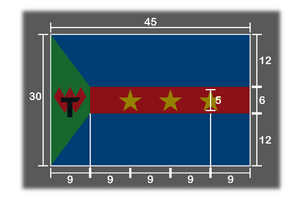
In history, there were several representative flags in Baijania. The current version was proposed in June 2017 and designed by the then head of state Tingwei Bai; Standardization will be carried out in November 2018 to facilitate printing and Internet access; In February 2019, the design was officially approved by a referendum and became an official national flag.
In the flag of the Federal Republic of Baijania, blue represents the northern and southern hemispheres; The three yellow five pointed stars refer to the national motto respectively: Democracy, Federation and Liberty; Green table refers to unknown western land or directly refers to land; The black torch means "the struggle for independence", or Baijania is endless.
Coat of Arms
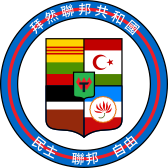
In history, Baijania used many Coat of Arms to represent the country; At the beginning of the establishment of the government in 2018, the first adopted national emblem was the Yellow Double-headed eagle, but it was immediately abandoned due to the informal Coat of Arms; The second edition of the national emblem is similar to the socialist emblem, but because the national emblem lacks some elements of Heraldry and is related to socialism, it was replaced by the new national emblem in the referendum in February the next year; The third edition of the national emblem is the coat of arms, in which there is a white dove symbolizing peace, and there are old shield beasts on both sides of the coat of arms. The top and bottom of the coat of arms are pentagonal Venus and ribbons respectively. The English of the national motto "democracy Federation freedom" is written, and the Russian version of the national emblem is "Демократия-Федерация-Свобода".
The current Coat of Arms was adopted on July 30, 2022 and designed by the then head of state Tingwei Bai.
The national emblem of the Federal Republic of Baijania takes the coat of arms as the main body, and the greater version can also be regarded as the seal. The blue, red and blue features of byzania are on the periphery of the coat of arms, and the "Federal Republic of Baijania (Chinese: 拜然聯邦共和國) " and the National motto "Democracy Federation Liberty (Chinese: 民主 聯邦 自由) " are written. The small national emblem is a simple coat of arms. The four quadrants are the Republic of Nusantara, the Inchi-Lacviet Republic, the Basay Republic and the Republic of Zuán-an, and the torch symbolizing the unification of byzania is in the middle.
National Anthem
In the history of the establishment of the Baijanian government, the national anthem has been approved three times - 2018, 2019 and 2020.
In June, 2018, the first officially approved national anthem of Baijania was the "National Anthem of the Federal Republic", composed by Axali Doëseb; In January, 2019, another national anthem, "Unity and Liberty", was passed by a referendum. It was composed by Mikhail khokhlov. After the return of Mongol-Ulus region on August 15, 2019, this song also happened to be a song symbolizing the reunification of Baijania.
The current national anthem of the Federal Republic of Baijania is "Our Republic", which has been officially adopted since February 23, 2020; On July 16, 2022, the lyrics were adopted to give the song the lofty status of the national anthem and sing it more solemnly. The tune was composed by the Bashkir musician Farit Idrisov.
Current lyrics:
| Chinese original | Romanization | English translation |
|---|---|---|
| 第一段
拜然聯邦,鮮花在盛放, 這是我們光榮的家鄉。 天空滿布著和平之光, 讓我們一起建設夢想。 副歌 把名揚,拜然聯邦, 我們的心中懷著希望。 太陽從東方彼岸照亮, 我的共和國,拜然聯邦! |
dì yī duàn
bài rán lián bāng, xiān huā zài shèng fàng, zhè shì wǒ mén guāng róng de jiā xiāng. tiān kōng mǎn bù zhù hé píng zhī guāng, ràng wǒ mén yī qǐ jiàn shè mèng xiǎng. fù gē bǎ míng yáng, bài rán lián bāng, wǒ mén de xīn zhōng huái zhuó xī wàng. tài yáng cóng dōng fāng bǐ àn zhào liàng, wǒ de gòng hé guó, bài rán lián bāng! |
I
Baijania, flowers in full bloom. Thy glorious Homeland of our people. Let thy peace fill your sky. Let's build our dreams together. Chorus Glory to Baijania! You are our only hope, and faith. The sun shines from the East. Our republic, Baijania! |
National Holiday
Baijania has many official national holidays, but generally speaking, people mainly celebrate the official holidays of the Republic of China or the folk holidays of Taiwan.
This is the list of national holidays in Baijania:
| Date | Name | Notes |
|---|---|---|
| 1 January | New Year's Day 元旦 |
|
| 25 February | National Symbol Day 國家象徵日 |
Since 2019 |
| 8 May | Independence day of the old Baijania Federation 老聯邦獨立日 |
|
| 18 May | National Humiliation Day 國恥日 |
The day the Communist Party seized power |
| 23 May | First Republic Independence Day 第一共和國獨立紀念日 |
The first foundation regime declared independence |
| 16 June | Government Digitization Day 政府職能線上化紀念日 |
Since 2020 |
| 23 June | National Day and the Second National Rejuvenation Day 國慶日暨國家二次復興紀念日 |
Since 2022 |
| 6 August | Victory Day Against Terrorism 反恐怖組織勝利紀念日 |
Since 2023 |
| 13 August | Constitution Day 憲法日 |
Since 2021 |
| 15 August | National Unification Day 國家統一紀念日 |
Since 2019; To commemorate the return of the ulus region. |
| 26 September to 28 September | National Humiliation Day 國恥日 |
Since 2021; National Subjugation Day |
| 10 October | National Day of the Republic of China 中華民國國慶日 |
|
| 11 October | The anniversary of the implementation of the National Recovery Plan 復興計畫實施紀念日 |
Since 2018 |
External links
- President's Official Portal website
- Official Facebook Fanpage of Baijania 24
- Official Instagram of Baijania 24
- Official Twitter of Baijania 24
- Official Youtube of Baijania 24
- ↑ Article 1, Clause 3 of the Constitution of the Federal Republic of Baijania: 國名「拜然聯邦共和國」及「拜然尼亞」、「拜然」、「拜聯」意義相同。
- ↑ Article 3 of the Constitution of the Federal Republic of Baijania: 拜然聯邦共和國為實行總統制之聯邦制國家。
- ↑ Announced his resignation on September 26, 2021.
- ↑ 1st Gosduma under the 2021 Constitution.
- ↑ Initially it was called Radiant Fatherland.
- ↑ Initially it was called Baijanian National Party.
- ↑ 3rd Parliament under Constitution 2019.
- ↑ Before the streamlining, the party had 9 of the 13 seats.
- ↑ Before the streamlining, the party had 4 of the 13 seats.
- ↑ 2nd Parliament under Constitution 2019.
- ↑ Initially named New Kuomingtang, there are two seats. Later, it merged with the TPP, which also has two seats.
- ↑ 1st Parliament under Constitution 2019.
- ↑ It was originally named National Republican Party, and later changed its name to Young Baijania Party.
- ↑ Initially it was called Hsieh's Beiyang.
- ↑ Article 53 of the Constitution of the Federal Republic of Baijania: 拜然聯邦共和國由州、共和國、蘇丹國及市之聯邦主體組成。
